Visiting the Iconic Mussenden Temple and Downhill Demesne
Mussenden Temple is situated on the northern coast of Ireland, near Castlerock in County Londonderry. It is located in the scenic Downhill Demesne and rests on the edge of a gradually eroding cliff, forming a more dramatic headland.
Mussenden Temple, a lovely building located on a 120 ft cliff top, has eroded over time. The views from the edge are breathtaking, offering spectacular views westwards over the golden sandy Downhill beach stretching to Magilligan Point and Donegal, and an eastward view towards east Castlerock beach. The location has been used in Game of Thrones for both Mussenden Temple and Downhill Beach as the setting for the Dragonstone exterior. Additionally, one can see Fair Head, Portrush, and Portstewart from this spot.
The site is easily accessible via the Causeway Coastal Route and Mussenden Road, making it a key stop for visitors exploring the North Coast of Northern Ireland.
What is a demesne?
The term ‘demesne’ is frequently used in various places in and the Republic, indicating that a section of the estate was enclosed by a wall and reserved solely for the landowner’s use. Downhill Castle, also referred to as a manor house or Downhill house, is an English-style estate of substantial size. The original mansion was designed by architect Michael Shanahan for Frederick Hervey.
Mussenden Temple tickets
The National Trust owns the Downhill Demesne and Downhill House Estate, and admission fees are as follows: Adults £7.20 (£6.50), children £3.60 (£3.25), and Family £18.00 (£16.25). During our visit in February, the gate was unattended, and we could enter free of charge. However, the Temple was closed, and we could only explore the grounds. These fees apply to visiting the entire estate, including the Demesne and Hazlett House.
Parking is available at the Lion’s Gate car park, which is conveniently located near site amenities such as toilets and picnic areas. The National Trust has implemented Pay by Phone parking at Lion’s Gate with car park fees for non-members at a rate of £5 per vehicle. National Trust members can enjoy free parking.
One possible solution is to take a walk to the Downhill Demesne. According to Walk NI, this is a viable option.
How to Get to Mussenden Temple and Downhill Demesne
Castlerock to Mussenden Temple walk
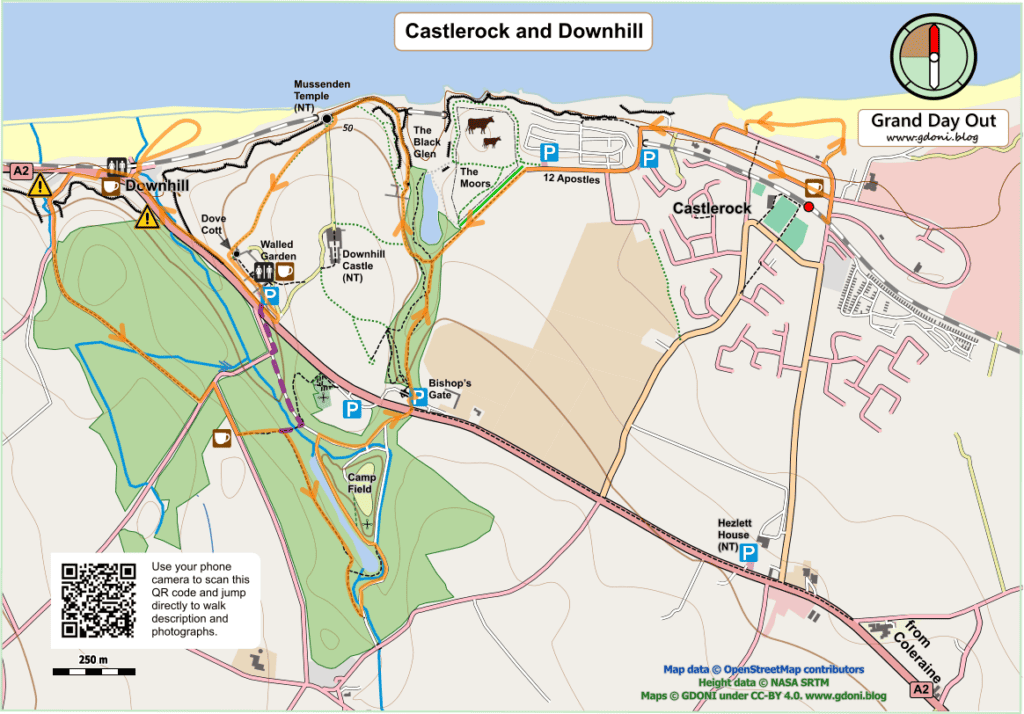
Castlerock to Mussenden Walk By Grand Day Out
The walking trail begins in a car park at the western end of Tunnel Brae in Castlerock, next to a black stone gate lodge. Walk over the stone step-over stile and continue along the stone path beside the caravan park boundary. Follow the mown grass track around the headland, called “The Moor” by locals, where a grass track leads towards the ruins and gardens.
At a certain point, take the right track to continue towards the temple. As you progress, the route transitions into a surfaced woodland path, offering a scenic and accessible walk through the estate. Further along, a well surfaced woodland path ensures comfortable footing for all visitors. For those seeking a bit more adventure, head west at the decision point to explore additional viewpoints.
Visitors can appreciate breathtaking panoramic views from this elevated coastal spot, which offers clear visibility of several landmarks. These include Donegal’s Inishowen peninsula to the west, the Giants Causeway and Antrim Hills to the east, and the Paps of Jura, Scottish Isles to the northeast. However, caution should always be exercised on this headland due to the dangerous cliff edges nearby.
As the walk continues, a steepish grass track leads up to a scenic viewpoint. Near the Mausoleum, use the starting point veer at the junction to guide yourself onto a different route towards the gardens or other key attractions.
Visitors can access the Museum Temple, Downhill Demesne, the Mausoleum, and the Belvedere for free by hiking. The ticket purchased also covers the Hezlett House in addition to these sites.
Driving to Mussenden Temple
The Downhill Demesne and Mussenden Temple are located 1 mile west of Castlerock and 5 miles west of Coleraine on the Coleraine to Downhill coast road. Drivers should enter via the Lion’s Gate to access the main car park, where visitors can park for free in the designated area.
Train to Mussenden Temple and Downhill Demesne
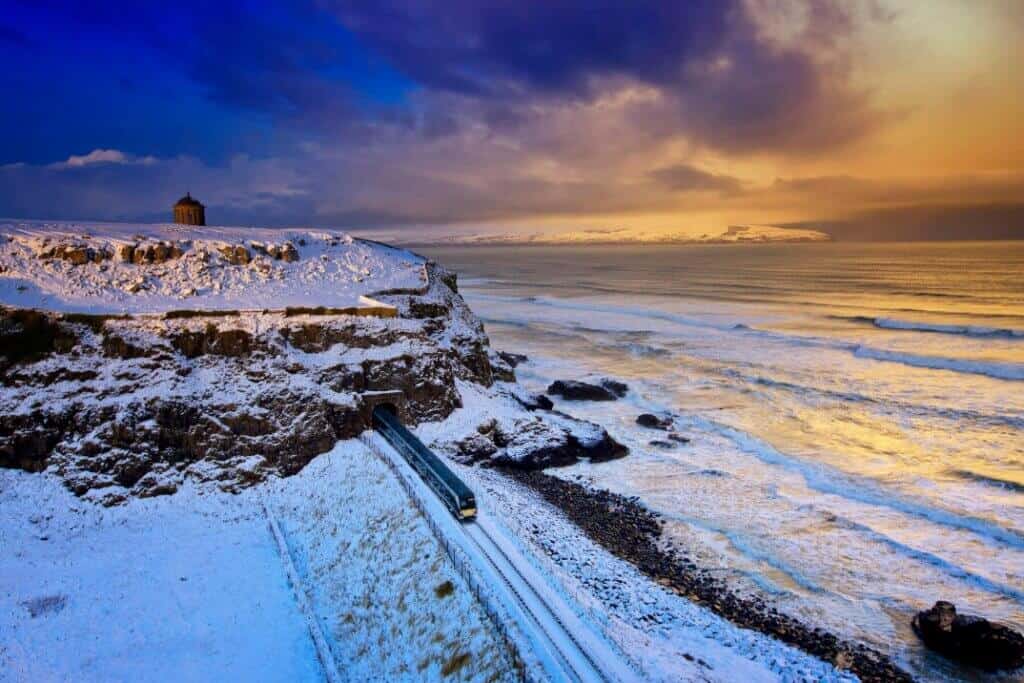
Photo Courtesy of Translink NI
To reach Mussenden, one can take a train from Belfast and purchase a ticket to Castlerock. From there, it is a 0.5-mile walk to Mussenden.
Mussenden Temple and Downhill Demesne By Bus
To reach the Temple and Demense from Coleraine, take the Ulsterbus 234 to Londonderry and inform the driver of your desired stop. A short 10-minute walk will bring you to your destination.
Mussenden Temple parking
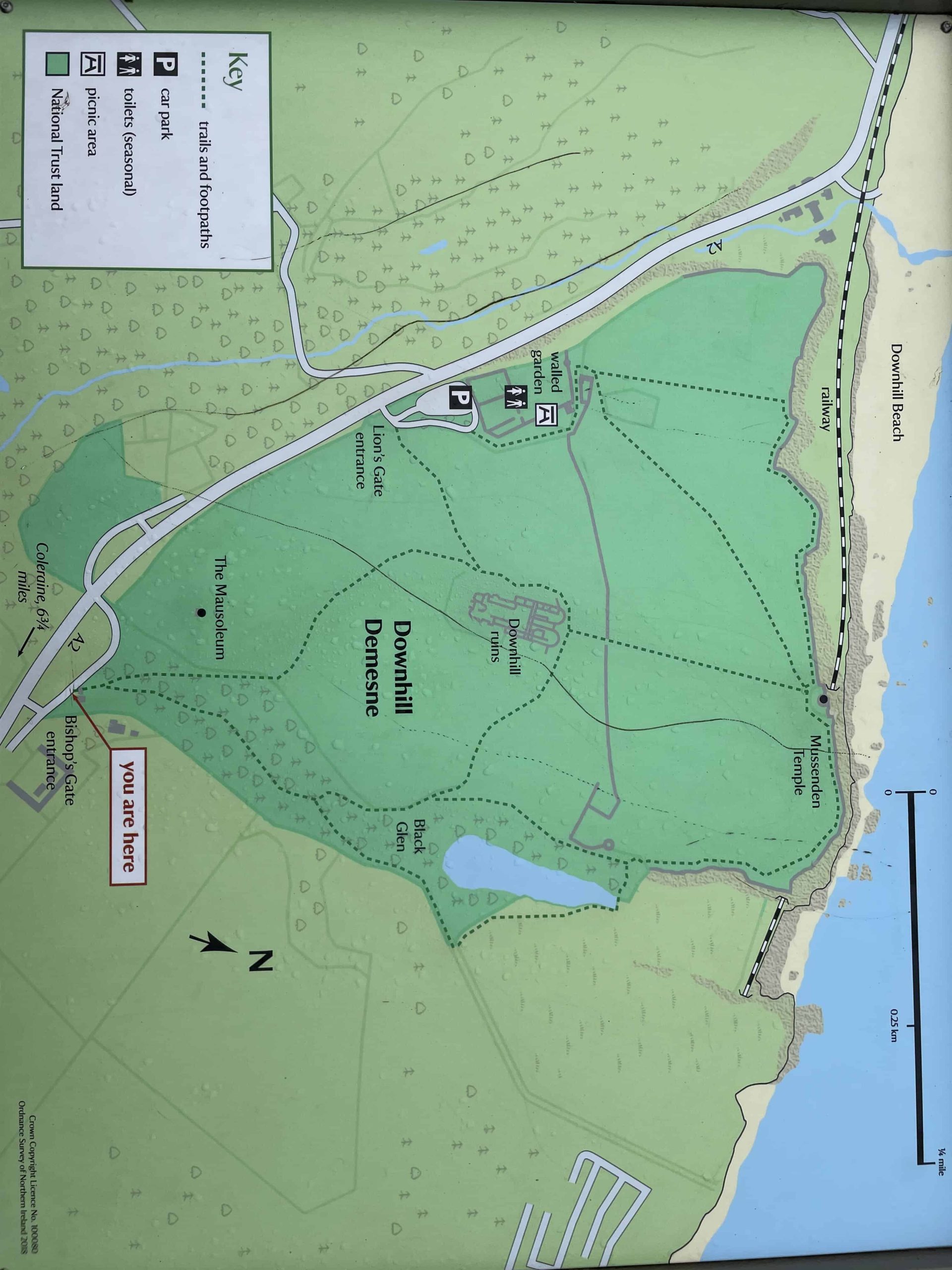
Pay by Phone parking is available at Lion’s Gate, and non-members are subject to car park charges of £5 per vehicle. National Trust members and blue badge holders (including those from the USA and Canada) receive free parking.
Mussenden Temple was built in 1783 and has experienced erosion over time, resulting in the loss of over 30 feet of cliff. As of 1997, it was only a few inches from the edge and at risk of collapsing into the sea.
The World Monuments Watch organization provided funding to stabilize the cliff using rock anchors, bolts, and dowels to prevent erosion and secure the escarpment. The National Trust carried out the cliff stabilization work to protect Mussenden Temple from further erosion and potential loss. The cavities and fissures on the cliff face were filled with pigmented mortar and local basalt. In 1998, the temple was secured, and markers were placed on the cliff face to allow for regular inspections and monitoring of erosion.
Frederick Hervey was a prominent figure in Ireland who advocated for political, social, and religious change. He supported unemployment relief initiatives and permitted Catholics to conduct mass in the Crypt of the temple.
In the past, Downhill House had impressive architectural features such as domes and Corinthian pilasters. The Lobby was spacious and held up by Derbyshire marble columns.
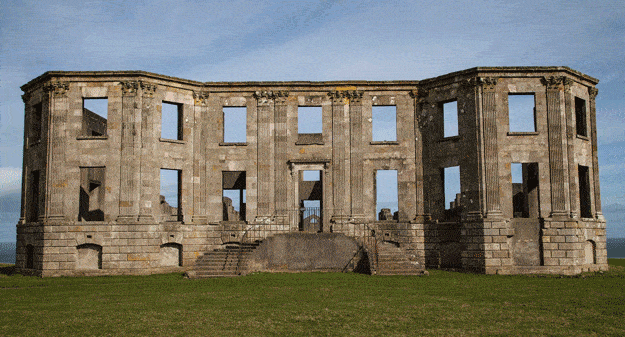
The Earl Bishop was passionate about travelling and his art collection, which he displayed in his house. He passed away in Italy in 1803, and his relative, Henry Bruce, inherited the House and made it his residence.
Downhill demesne was damaged by a fire in 1851 and was not restored. By 1950, the roof had deteriorated, leaving the house in ruins.
Mussenden Temple was originally constructed as a library for Frideswide Bruce, the niece of the 4th Earl of Bristol and Bishop of Derry. Their relationship was considered scandalous at the time.
After marrying a wealthy London banker named Daniel Mussenden, the Bishop gifted Frideswide with Mussenden Temple as her personal retreat.
Frideswide passed away in 1785 due to her deteriorating health, which may have been worsened by the scandal, resulting in the conversion of Mussenden Temple into a memorial in her honour.
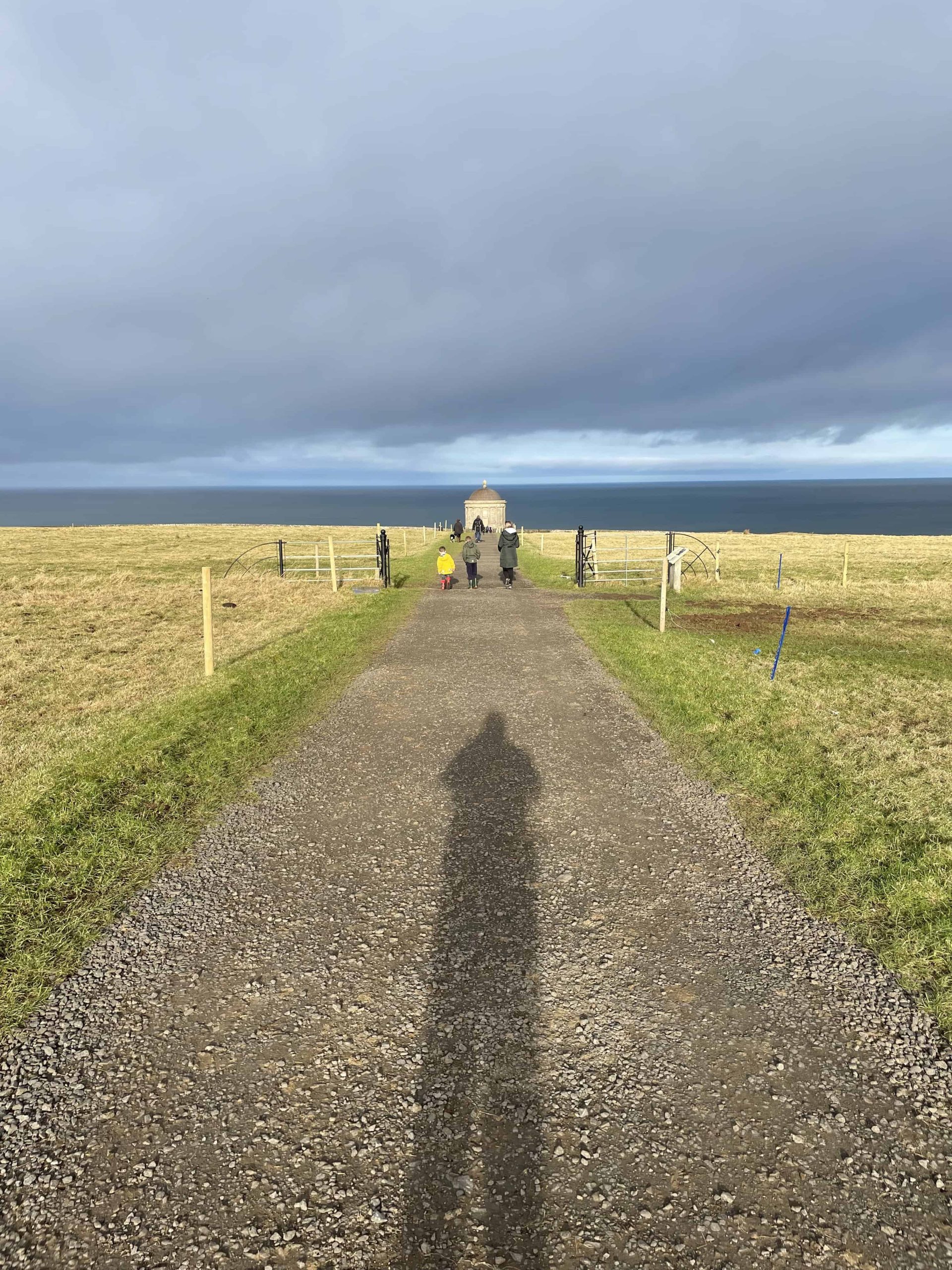
The Temple of Vesta inspired the temple in Tivoli near Rome. Originally intended as a summer library, it had a heating system powered by a fire beneath the floor. This system prevented the books stored inside from becoming damp due to the influence of the sea air.
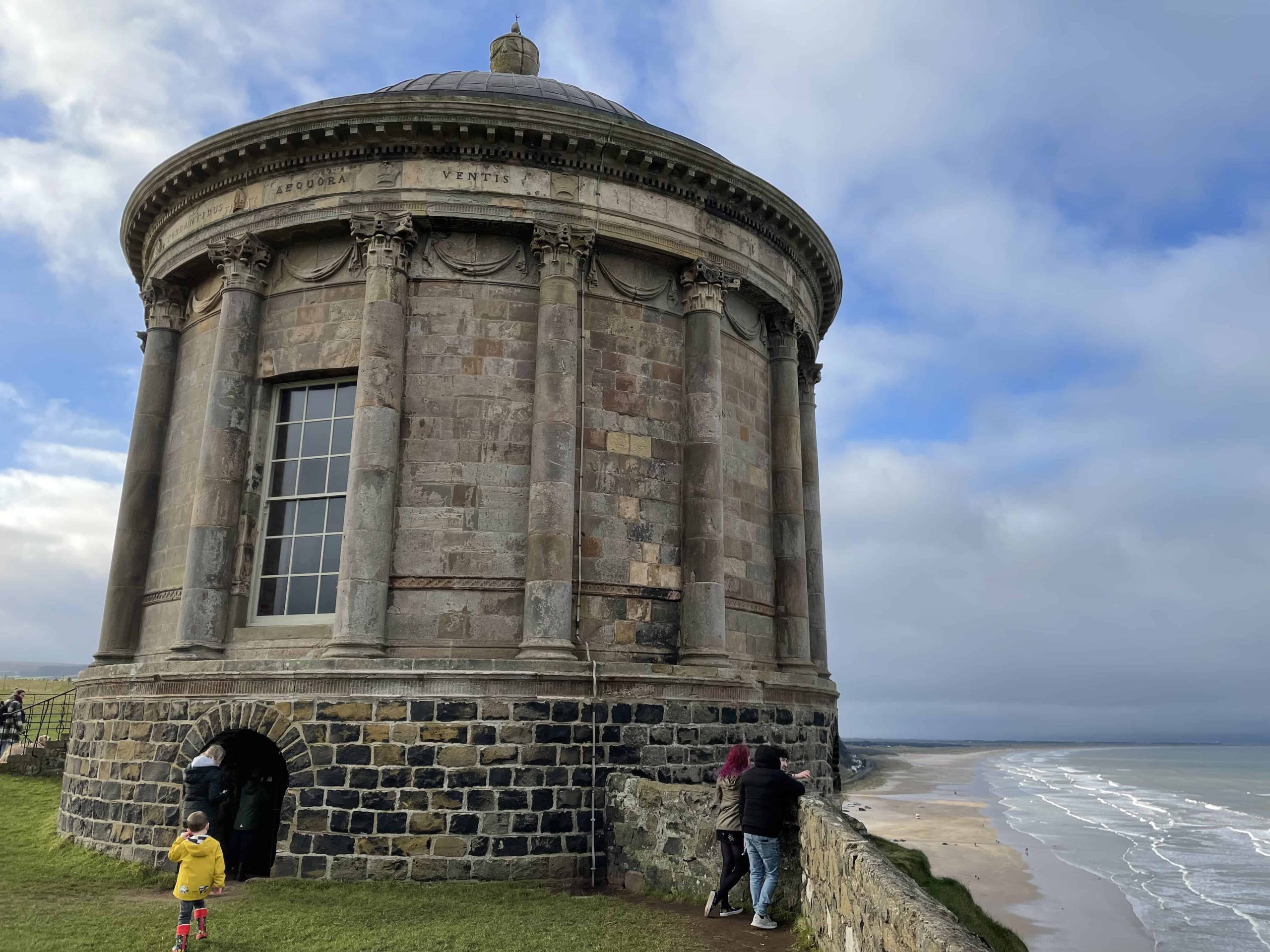
The inscription around the building reads:
“Tis pleasant, safely to behold from shore The troubled sailor, and hear the tempests roar.”
The Earl-Bishop designed the grounds in the 18th century, and they are now part of the Downhill & Mussenden Temple Estate, owned by The National Trust.
The Estate features several attractions, including the Gateway, House ruins, gardens, Mausoleum, woodland and cliff walks, fish pond, and family memorials.
The Lions Gate
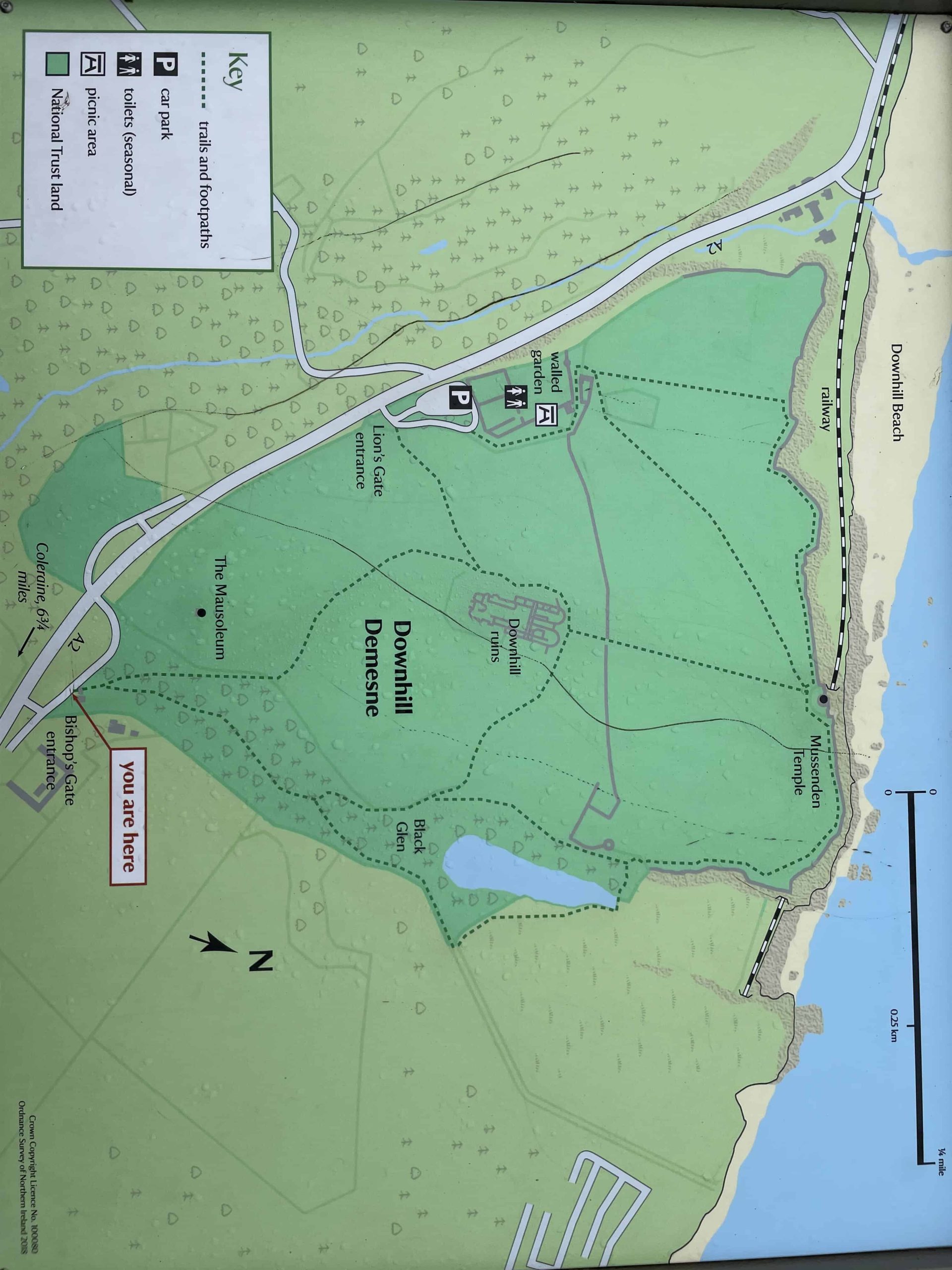
The Lion’s Gate is one of the property’s two entrances. The pillars have been restored and are adorned with stone snow leopards. The gate lodge at the Lion’s Gate is a private residence and is not open to visitors.
Al’s Coffee, visible from the Lion’s Gate entrance, is worth mentioning. Al is a Scottish man selling coffee on an Irish estate, and his coffee is exceptional. It is the best coffee I have had in Ireland, so good that I didn’t need to add sugar. I highly recommend stopping by Al’s for a great cup of coffee.
The Bishop’s Gate
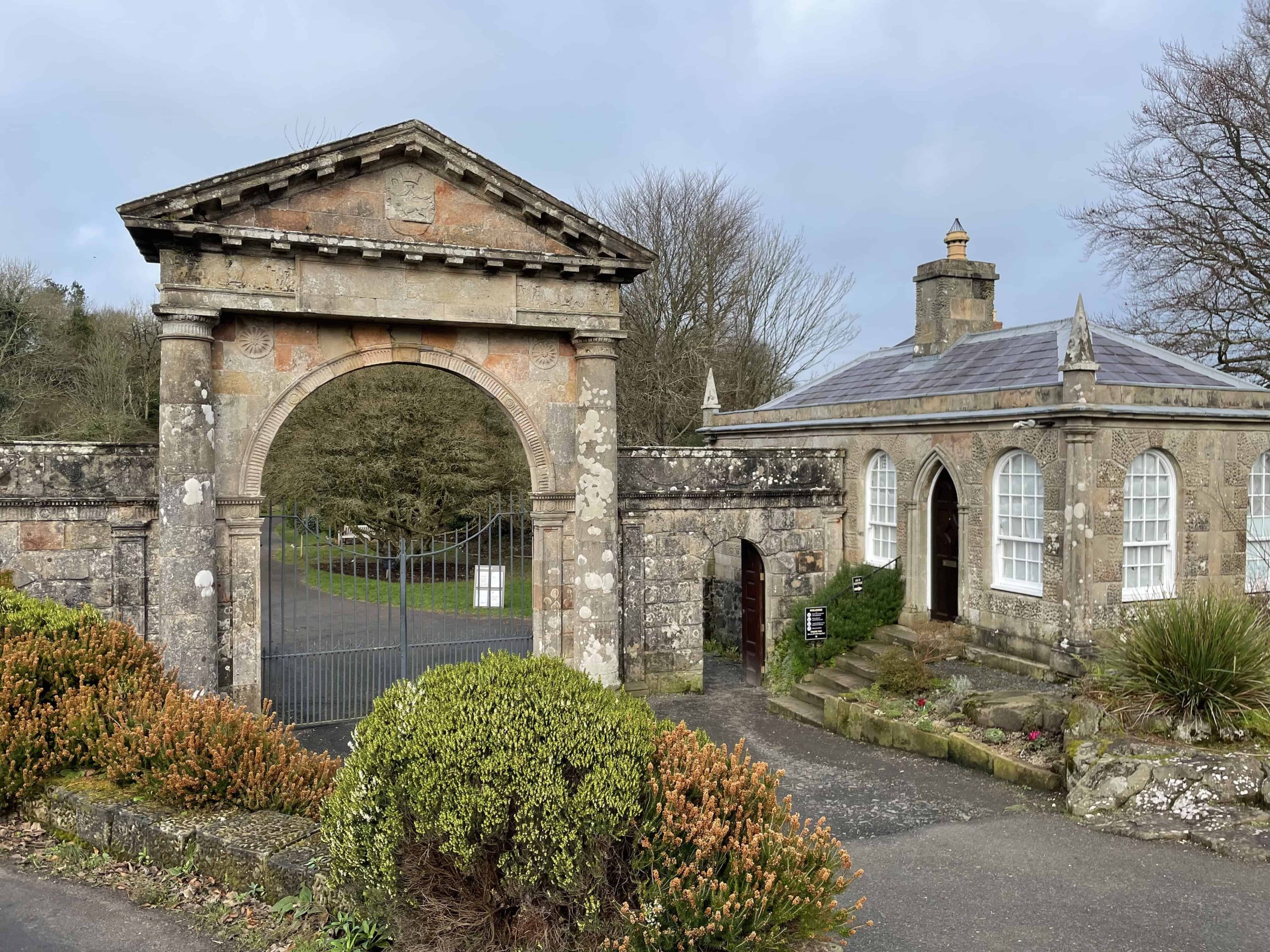
The Bishop’s Gate entrance features a Gothic gate lodge near the Bishop’s Gate Gardens and Black Glen. Visitors can observe symbolic carvings, such as a bishop’s mitre and cow skulls.
The Black Glen
The Temple’s location on the Causeway coastal headland offers picturesque views and is a popular spot for photography in Northern Ireland.
This garden is dedicated to trees and provides a pleasant walk, sheltered from the strong winds that can occur on the nearby cliff edge.
Lady Erne’s Seat
The Belvedere, sometimes referred to as Lady Erne’s Seat, is a peaceful summer house belonging to Mary, the bishop’s daughter. It offers a serene view of the sea and is a fitting prize for the uphill trek from the Black Glen.
The Bog Garden
The unusual bog garden near Bishop’s Gate contains diverse blooms, including beautiful irises. Lady Bruce established the garden in 1910.
The Mausoleum
The cenotaph was constructed as a tribute to George Hervey, the brother of Earl Bishop. There is reportedly a statue of George on the premises that was knocked over during a windstorm.
Dovecote and Icehouse
The building is an unusual built feature of the estate, with a dual purpose: an icehouse on the lower level and a dovecote, which is a circular type building, on the upper level. It was used for storing ice that was cut from a nearby pond.
The Walled Garden
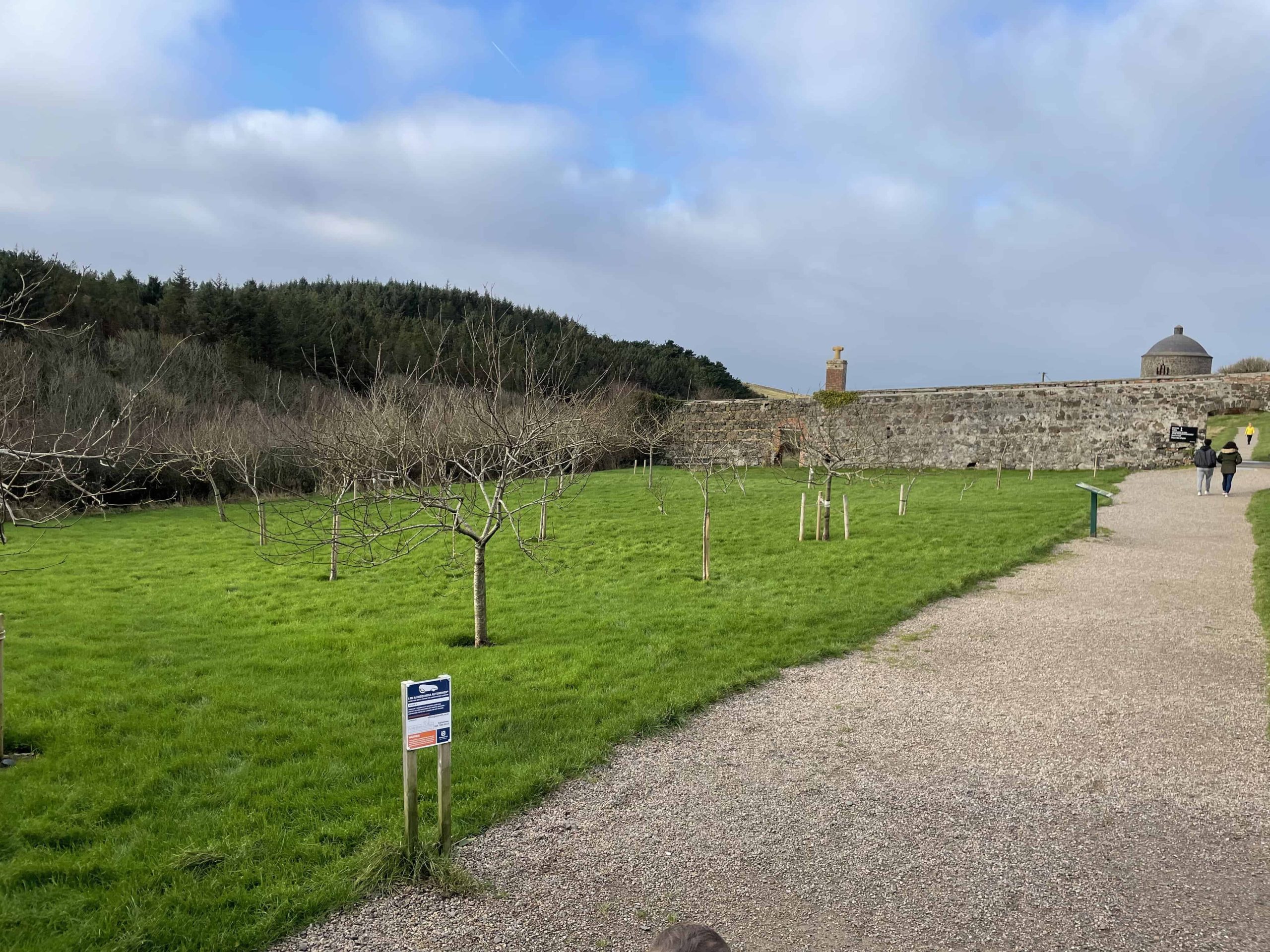
The garden at Downhill Demesne was once a vital source of fruits, vegetables, and flowers. Today, when entering the grounds, the walled garden appears as a picturesque, almost fantasy-like landscape within the estate, though it is now mostly occupied by a small herd of sheep and a few apple trees, with little evidence of its former beauty remaining.
Mussenden Temple and the Downhill Demesne in Ireland offer a distinctive location for weddings. The cost of a Mussenden temple wedding will depend on the selected package, including decor, a wedding planner, a photographer, and other expenses.
Downhill Forest
Nestled along the rugged north coast of Northern Ireland, Downhill Forest provides a captivating backdrop for the iconic Mussenden Temple. A mix of woodland and open spaces, the forest is a haven for both local wildlife and visitors seeking a serene escape. Ancient trees, winding pathways, and picturesque glades make Downhill Forest a favorite spot for walkers, photographers, and nature lovers. As you explore, you may encounter a small wooden gate along the woodland paths; at the small wooden gate proceed straight ahead to continue your journey through the forest. These paths lead through tranquil woods to scenic viewpoints and ultimately to the temple itself. Overlooking the vast Atlantic Ocean, Mussenden Temple stands as a testament to the blending of man-made beauty with the wild, untouched charm of the forest. The juxtaposition of the historic temple against the lush greens and roaring ocean creates a mesmerizing vista that captivates all who visit. This unique blend of architectural splendor and natural beauty makes the Downhill Forest and Mussenden Temple a must-visit destination on Northern Ireland’s coast.
Gortmore Viewpoint
Perched on the Binevenagh Mountain, Gortmore Viewpoint offers one of the most breathtaking panoramas in Northern Ireland. The viewpoint, marked by the iconic sculpture of Manannán mac Lir, the Celtic god of the sea, provides sweeping vistas of the vast Atlantic Ocean, Magilligan Point, the distant Donegal hills, and across Ireland’s north coast. The uninterrupted scenes from this vantage point are a testament to the rugged beauty of the North Coast.
A short drive from Mussenden Temple, Gortmore’s superb viewpoint is situated overlooking Downhill Cliffs and Ireland’s north coast. The temple and Gortmore Viewpoint together epitomize the blend of natural beauty and human ingenuity that characterizes this unique coastal region. The proximity of these two landmarks allows visitors to immerse themselves in the rich tapestry of Northern Ireland’s history, mythology, and unparalleled scenic beauty.
Conservation Efforts at Mussenden Temple and Downhill Demesne
Mussenden Temple and Downhill Demesne, perched on the north western coast of Northern Ireland, are not only iconic landmarks but also treasures of outstanding natural beauty. The National Trust has played a vital role in safeguarding this dramatic headland, ensuring that the unique blend of history, architecture, and landscape endures for generations to come.
One of the most significant conservation achievements at the site was the extensive cliff stabilisation work, which protected Mussenden Temple from the relentless erosion of the cliff edge. Thanks to these efforts, visitors can still marvel at the temple’s commanding position above Downhill Strand, with spectacular views stretching across Ireland’s north coast to the Scottish Western Isles and Fair Head. The National Trust’s ongoing commitment to preserving the downhill demesne and mussenden temple means that the dramatic coastal scenery and cliff top walks remain safe and accessible.
Beyond the cliffs, the National Trust has carefully restored features of the downhill estate, including the enchanting walled garden and the historic ice house. The walled garden, once a productive heart of Downhill House, now appears as a whimsical landscape, while the ice house offers a glimpse into the ingenuity of the estate’s past. The arboretum, home to many rare tree species, is protected and maintained, allowing visitors to enjoy leisurely strolls along well surfaced woodland paths and steepish grass tracks that wind through beautiful gardens and hay meadows.
Visitor access is thoughtfully managed, with mown grass tracks and surfaced woodland paths designed to minimize environmental impact while guiding guests to the most photographed scenes and panoramic viewpoints. National Trust entrance fees and car park charges directly support these conservation projects, helping to maintain the site’s iconic buildings and natural habitats. National Trust members enjoy free access, and their support is crucial in preserving the legacy of the earl bishop and the remarkable features of the downhill demesne mussenden temple.
By exploring the temple and downhill demesne, visitors not only experience the breathtaking beauty of the north coast but also contribute to the ongoing preservation of this historic estate. Whether wandering through the restored gardens, following the grass track to the cliff edge, or simply soaking in the spectacular views, every visit helps ensure that Mussenden Temple and Downhill Demesne remain a jewel of Northern Ireland’s heritage.
Mussenden Temple Facts
Who built Mussenden Temple?
The Downhill Demesne estate was built in the late 1700s for Frederick Hervey, the Bishop of Derry and Earl of Bristol.
The term ‘demesne’ is commonly used in Northern Ireland and the Republic to refer to a walled section of an estate reserved exclusively for the landowner’s use.
What was Mussenden Temple used for?
The temple’s purpose was to serve as a summer library, and it was designed with inspiration from the Temple of Vesta, located near Rome in Tivoli.
Mussenden Temple offers stunning views of the Northern Irish coastline. It has a rich history and breathtaking scenery, making it a unique and memorable experience. Whether you’re a history buff or just looking for a leisurely day out, Mussenden Temple has something to offer everyone. Pack a picnic and spend a lazy afternoon taking in the sights at one of Ireland’s most picturesque locations. You won’t be disappointed.

